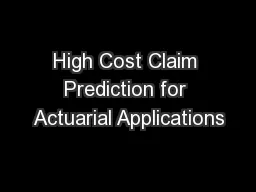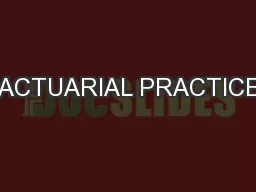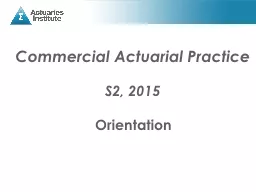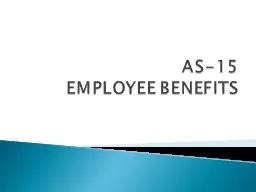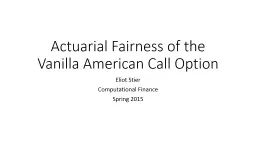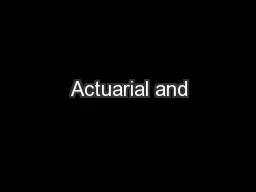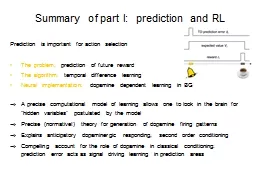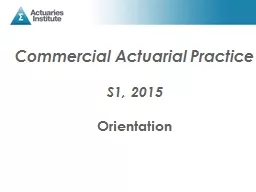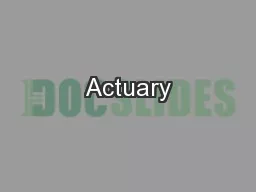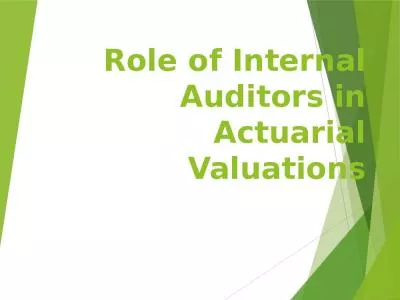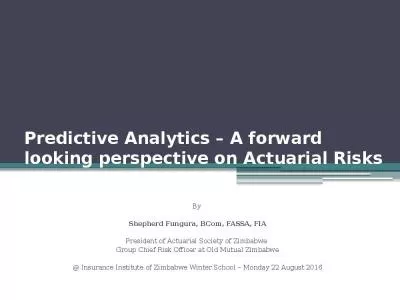PPT-High Cost Claim Prediction for Actuarial Applications
Author : tatyana-admore | Published Date : 2017-06-05
Vincent Kane FSA MAAA Research Scientist DxCG A Division of Urix Inc The Second National Predictive Modeling Summit Washington DC September 22 2008 Predictive Modeling
Presentation Embed Code
Download Presentation
Download Presentation The PPT/PDF document "High Cost Claim Prediction for Actuarial..." is the property of its rightful owner. Permission is granted to download and print the materials on this website for personal, non-commercial use only, and to display it on your personal computer provided you do not modify the materials and that you retain all copyright notices contained in the materials. By downloading content from our website, you accept the terms of this agreement.
High Cost Claim Prediction for Actuarial Applications: Transcript
Vincent Kane FSA MAAA Research Scientist DxCG A Division of Urix Inc The Second National Predictive Modeling Summit Washington DC September 22 2008 Predictive Modeling vs Risk Adjustment. Committee on Professionalism Education. Agenda. Professional Guidance. Skit. Small Group Discussion. Large Group Discussion. Takeaways. Professional Guidance. Precept 1 of the Code of Conduct: An Actuary shall act honestly, with integrity and competence, and in a manner to fulfill the profession's responsibility to the public and to uphold the reputation of the actuarial profession.. ASSK PRESENTATION. 28. TH. NOVEMBER 2014. NAIROBI SAFARI CLUB. EZEKIEL MACHARIA. AGENDA. Specialization Areas. Role of an Actuary. Focus on Kenya and East Africa. Role of TASK. Using New Technology. S2, 2015. Orientation. Commercial Actuarial Practice. Communication. The Course. Case Studies. Pre-Course Work. Assessment. Logistics. 2. CAP Orientation S2, 2015. Commercial Actuarial Practice. 3. CAP Orientation S2, 2015. EMPLOYEE BENEFITS. Daimler Benz in 1993 under German GAAP reported a profit of 168 million DM but under US GAAP for the same period, the company reported a loss of almost a billion DM, largely caused by pension blues. It highlighted problems relating to pension accounting & funding. . existing international actuarial notation was founded on the ' Key to the Notation' given in the Institute of Actuaries Text-Book, Part II, Life Con- tingencies, by George King, and is embodied in an Eliot . Stier. Computational Finance. Spring 2015. Introduction. Does an empirical analysis indicate that call options are actuarially fair?. Would a trader earn more from a leveraged purchase of the underlying equity or a call option?. Maths. Applications and Interviews. Bruce Woodcock . University of Kent Careers & Employability Service . You can download a copy of this presentation . at . www.kent.ac.uk/careers/slides.htm. . Prediction is important for action selection. The problem:. prediction of future reward. The algorithm:. temporal difference learning. Neural implementation:. dopamine dependent learning in BG. A precise computational model of learning allows one to look in the brain for “hidden variables” postulated by the model. existing international actuarial notation was founded on the ' Key to the Notation' given in the Institute of Actuaries Text-Book, Part II, Life Con- tingencies, by George King, and is embodied in an S1, 2015. Orientation. Commercial Actuarial Practice. Communication. The Course. Case Studies. Pre-Course Work. Assessment. Logistics. 2. CAP Orientation S1, 2015. Commercial Actuarial Practice. 3. CAP Orientation S1, 2015. – . What They Do. “Risk Analyst” – Uses Statistics and Probability Theory to quantify risks. . Informs the business management about the quantified risk, and help with making business decision. . February 28, 2014. Tisha Abastillas, FCAS. Outline. What is an Actuary?. What does an Actuary do?. How do you become an Actuary?. The Casualty Actuarial Society (CAS). Why become an Actuary?. What can you do right now?. OBJECTIVE . OF THE VALUATION . THE . ROLE PLAYERS. . . M. anagement’s . role . Role of internal audit and reliance on the work of actuarial expert. Internal audit is required to develop a risk based plan and this is done through development... By . Shepherd Fungura, . BCom. , FASSA, FIA. President of Actuarial Society of Zimbabwe . Group Chief Risk Officer at Old Mutual Zimbabwe. @. Insurance Institute of Zimbabwe Winter School – Monday 22 August 2016.
Download Document
Here is the link to download the presentation.
"High Cost Claim Prediction for Actuarial Applications"The content belongs to its owner. You may download and print it for personal use, without modification, and keep all copyright notices. By downloading, you agree to these terms.
Related Documents

